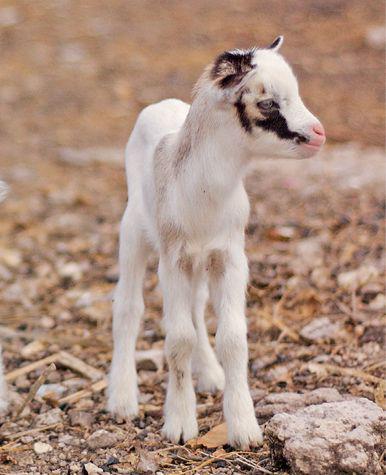Authors: Betsy Matheson
Tags: #Non-Fiction
DIY Projects for the Self-Sufficient Homeowner: 25 Ways to Build a Self-Reliant Lifestyle (28 page)

Pigs love attention
and are infinitely curious. Be sure to build a strong fence around your pigpen to keep your pigs contained.
 Goats
GoatsGoats are mischievous class clowns with boundless energy and a lovable nature. They are a great source of both milk and meat, and do not require a vast amount of resources, food, or shelter. They are ruminants that enjoy munching twigs and leafy brush—but if you will be raising goats for their milk, feed them with a forage of hay and grain to preserve their milk’s taste. Some goat breeds are also a great source of fibers for fabrics, such as mohair and angora. You’ll want to watch these breeds’ diets carefully, as their coat will be affected by their diet. Feed them only quality pasture or hay, along with plenty of fresh, clean water.
There’s no need to build a fancy house for goats, as they fare well in pretty much any dry, draft-free quarters. Goats are prone to respiratory problems triggered by a moist environment, so avoid heating that can result in condensation. House goats in a three-sided barn, shed, or a shared barn with other animals. It’s a good idea to invest your savings on shelter in quality fencing, however. Woven-wire pasture fencing is ideal, and additional strands of barbed or electrical wire will discourage curious goats from escaping.

Goats are high-spirited,
lovable, and mischievous animals that love to play. Watch out, though—your goats will try to outsmart you (or your fence!). Goats are a great source of milk, wool, and meat.
 Sheep
SheepSheep are affectionate animals raised most often for their high-quality wool that can be spun into yarn and made into warm textiles. Choose a breed of sheep with a wool density that correlates with the weather where you live—in the north, choose sheep with extra “lining” in their coats; in temperate or arid climates, sheep with fine wool and hair prosper.
When purchasing sheep, look for healthy feet. From the front view, legs and hooves should align, as opposed to being knock-kneed, splayfooted, or pigeon-toed. Check the animal’s bite, and be sure there are no udder lumps or skin lesions. Sheep do need to be shorn every spring before the weather heats up, so take good care of your sheep’s wool and sell or spin it after it is collected. To care for your sheep (and their wool), make sure they have good nutrition, well-managed pastures, and vaccinations. Sheep need a sturdy fence and some type of shelter, though existing buildings on your land will suit them just fine. They are easy targets for predators, such as coyotes, so make certain your fence is secure.

Sheep travel in close-knit packs,
are spooked easily, and are an easy target for predators, so make sure your sheep are protected by a secure fence.
 Alpacas
AlpacasAlpacas are smaller cousins to llamas and camels and are an approachable, friendly species, which makes them appealing to landowners who want to begin caring for animals. They won’t challenge your fencing or trample your pasture. They also require little feed—about a third less than a sheep. Alpacas grow thick coats that are five times warmer than wool and far more durable. Yarn spinners covet alpaca fiber, homeowners admire these loving pets, and investors appreciate the potential returns these valuable creatures promise.
Fencing you’ll build for alpacas is designed more to keep predators out than to keep alpacas in. These animals are not ambitious escape artists—not nearly as tricky as goats. But predators can represent a threat to sensitive alpacas, so it’s a good idea to install strong perimeter fencing that is at least five feet tall. Separate females and males with fencing. Females and their newborns must have separate quarters from the rest of the pack, but do not completely isolate them from the group. A three-sided shelter is adequate for alpacas, which are accustomed to rugged, cold climates. Heat is more of a concern for these animals, and their insulating fiber coats are no help in keeping them cool in summer. A misting system or fans in the alpaca shelter will prevent them from overheating.

Lock eyes
with a quizzical alpaca and you’ll feel like you are being probed for information. Alpacas are gentle animals that are easy to care for and produce soft, extremely warm coats that can be shorn and sold to textile makers.

Vinyl fencing
is durable and virtually maintenance free. However, damaged pieces are expensive to replace and materials can cost up to twice as much as a traditional wood fence. For these reasons, most landowners use vinyl to enclose smaller areas.
 Fences
FencesFencing plays a critical role in controlling animals, keeping out predators, sectioning off pastures, drawing property lines, and adding aesthetic appeal to properties. Your fencing needs will vary depending on the size of your lot and what type of animals call your land home (pigs, chickens, horses). Hobby farms will require functional fences, but if you live on a country estate, the reasons for your fence may be purely aesthetic. There are materials and designs that accommodate both goals.
Fence Materials
Progress in fencing is evident in the type of materials available, synthetics like PVC, and the improved life expectancy of good old standards like wood and wire, which can be treated with a vinyl coating. High-tensile wire fencing can last up to 50 years. But the more traditional types, such as split-rail, Virginia rail, and post-and-rail, will always have their place.
Before choosing fencing material, ask yourself the following: How large is the area to be fenced? What is the purpose of your fence? Will you install it yourself or hire a professional? How much are you willing to spend?


